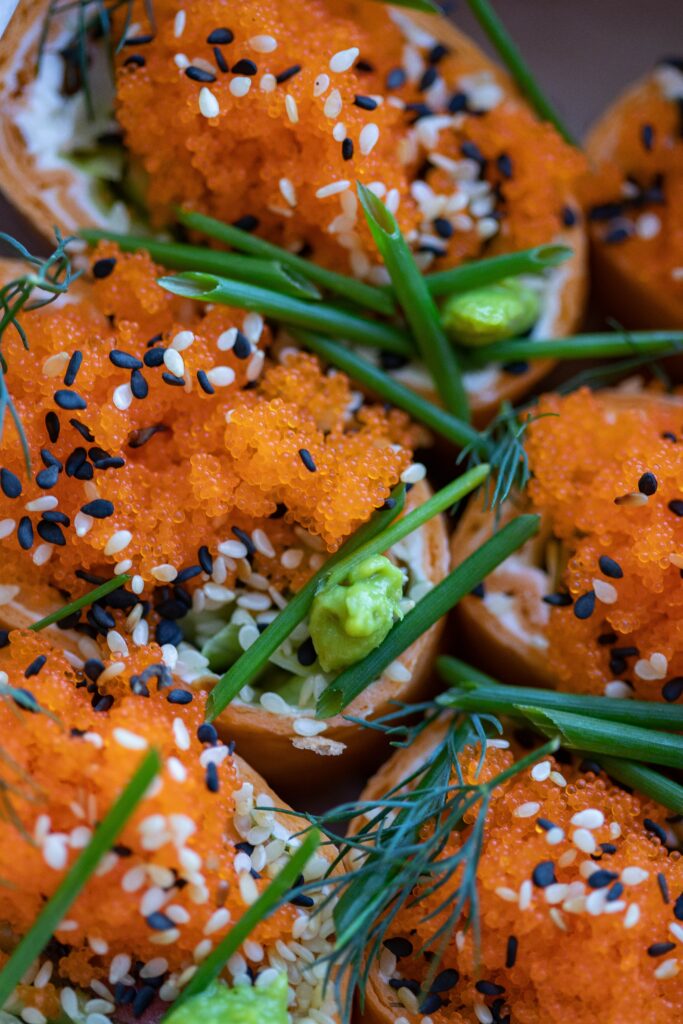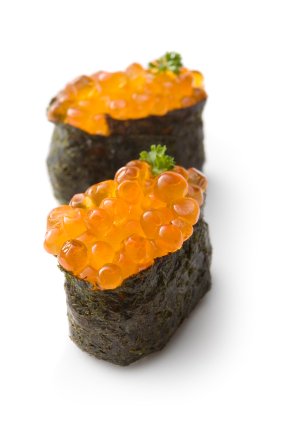What is Tobiko?
Tobiko isn’t very expensive in comparison with alternative Caviars which makes it very popular among sushi chefs. Tobiko is quite a newfangled ingredient, even among the sushi masters of Japan.

How is Tobiko harvested?
Tobiko is harvested from saltwater fish, so it has to be done in the East China Sea, usually in the northern Taiwan Strait. Also referred to as ‘flying fish roe’, it is harvested in an ingenious way that makes use of the natural behavior of the fish themselves.
When fish mate in a general sense, the female fish release eggs into the seawater, which float around waiting to be fertilized. When flying fish mate, though, they release eggs in order to attach themselves to floating objects in the sea – typically small rafts of seaweed.
Skilled fishermen create large balls of seaweed which they tie to their boat, and then pull in when enough roe has been accumulated on their surface. This takes a lot of skill and experience to time their efforts perfectly – the eggs are likely to be knocked off or pulled in too soon by a rookie fisherman.
Interestingly, flying fish are extremely resilient in their assorted mating habits. They are thought to be immune to intense fishing pressures, regardless of how much they may be fished. However, as fishing eggs interrupts the breeding cycle of the fish, the precise effect that it might have is generally unknown. Therefore – the population of flying fish is monitored very intensely.

How is tobiko used in sushi?
Tobiko in particular is considered to be one of the most prized fish eggs used in sushi. They are used in a number of different ways thanks to how special they are considered to be, including on their own, or as a garnish.
When used on their own, they are served in sashimi. Of course, sashimi is thin slices of fish, served similarly to charcuterie. The tobiko is typically served alongside these slices of fish and is eaten alone rather than being a small part of a general mouthful.
As a quick note on sashimi tobiko, it can be quite hard to spot them! They come in black, green, yellow, and red varieties, meaning that knowing what the mysterious pile of eggs is on your plate can be tricky. Always make sure to ask – an informed meal is a great one!

When not used in sashimi, tobiko is used very sparingly in sushi. They are very prized among types of fish eggs, which means that they’re used as a slight garnish or finishing touch. They might be placed on top of or alongside the rolls, to make the plate look particularly appealing.
What does tobiko taste like?
Well, the taste of tobiko is most new and a little odd.
On the one hand, it’s precisely what you’d expect: smoky and salty. Tobiko is salt-cured, which means that it absorbs a lot of salt and flavors from the brine it is in before it gets to your mouth. This is the case with a lot of different types of roe, so that particular flavor is quite ubiquitous.
However, when compared to another roe, it’s also a little sweeter. A point a lot of people compare it to is caviar, or ikura – which tobiko is noticeably sweeter than.
While this isn’t necessarily to do with taste, we found out an interesting fact about tobiko as we were researching for this article. An individual tobiko egg is between 0.5 and 0.8mm in diameter. As a point of reference, the average width of a piece of graphite in a mechanical pencil is 0.7mm – these eggs are tiny!
What is the history of tobiko?
The history of tobiko is actually quite an interesting one. It hasn’t been used in Japan until very recently, so it’s quite a modern thing there as much as it is here.
It has been historically eaten in the Shimane Prefecture, but not at great length as one might eat chicken. It has always been very tricky to harvest, leading to the roe being generally quite rare.
However, in the early eighties, some Japanese chefs discovered that in the process of fishing for fish, some fishermen would throw away roe, thinking it useless. A deal was struck, and now tobiko is much more common in Japanese cuisine.
Whether or not you’ve had tobiko before now, we’d recommend seeking some out – it’s a tasty treat that’s hard to say no to if you’re a fan of seafood. Give it a go soon, you won’t regret it!
Where can I get me some Tobiko?
As in most sushi ingredients, you can find Tobiko at your local Asian food store or Japanese market. Tobiko is also available on our online store and through the link below.


Rate this recipe
4 People Rated This Recipe
Average Rating
No comments yet.